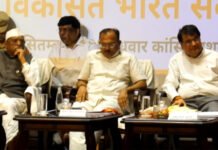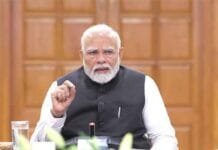In a historic political milestone, Prime Minister Narendra Modi has officially surpassed Indira Gandhi’s tenure as Prime Minister of India, becoming the second longest-serving PM in the nation’s history. On July 25, 2025, PM Modi completed 4,078 consecutive days in office, edging past Indira Gandhi’s uninterrupted term of 4,077 days from January 24, 1966, to March 24, 1977.
Narendra Modi: Second Only to Nehru in Longevity
The only Prime Minister to serve longer than Modi is Jawaharlal Nehru, India’s first PM, who held office for an uninterrupted 16 years and 286 days from August 15, 1947, to May 27, 1964. Modi now holds the second spot in India’s post-independence political history, firmly establishing his dominance in national governance.
This achievement is not merely a number—it reflects the unshaken political mandate, unmatched public support, and organizational discipline that have defined Modi’s leadership.
First Post-Independence Born Prime Minister to Achieve This Feat
Narendra Modi is the first Prime Minister born after 1947 independence to attain this record. Born on September 17, 1950, in Vadnagar, Gujarat, he symbolizes a generational transition in Indian leadership—from the freedom struggle era to the post-independence republic.
Modi’s rise marks a paradigm shift in Indian politics. Unlike previous leaders tied to dynastic roots or the Congress legacy, Modi emerged from a humble background and rose through the ranks of the BJP and the Rashtriya Swayamsevak Sangh (RSS).
Longest Cumulative Governance: State and Center Combined
When analyzing the combined tenure of state and central leadership, Narendra Modi holds the absolute record among all Indian Prime Ministers. He governed Gujarat as Chief Minister for over 13 years (2001–2014) before ascending to the national stage in May 2014. Combined, he has governed for over 24 consecutive years, an unmatched legacy in Indian executive leadership.
Only Non-Congress PM to Serve Two Full Terms
Modi is the first and only non-Congress Prime Minister in Indian history to complete two full terms in office—2014 to 2019 and 2019 to 2024—and is now serving his third term, beginning in June 2024.
This level of electoral success and sustained governance had previously only been accomplished by Congress stalwarts such as Nehru and Indira Gandhi, making Modi’s record all the more historic in a post-Congress era.
Absolute Majority Twice in a Row: A Unique Political Feat
Narendra Modi has redefined the landscape of Indian electoral politics. In 2014, his party, the Bharatiya Janata Party (BJP), became the first non-Congress party to win an absolute majority on its own in the Lok Sabha. In 2019, the BJP repeated this performance with an even larger mandate—a rare phenomenon in Indian parliamentary history.
Only Indira Gandhi, after the 1971 elections, had previously secured back-to-back absolute majorities. Modi now stands as the only other Prime Minister in India’s democratic journey to achieve this milestone.
Three General Election Wins: A Nehruvian Record Equaled
Before Narendra Modi, only Jawaharlal Nehru had won three successive general elections as Prime Minister—in 1952, 1957, and 1962. Modi matched this record with massive victories in 2014, 2019, and 2024.
In doing so, Modi cements his legacy as a mass leader with enduring popularity across diverse demographics and regions of India, including Hindi heartlands, coastal belts, and North-Eastern states.
Six Consecutive Wins as Party Leader: A Streak Unbroken
Modi’s electoral success spans not just the national stage but also state-level governance. As BJP’s face in Gujarat, he led the party to three back-to-back victories in 2002, 2007, and 2012. He then followed it with three consecutive general election wins in 2014, 2019, and 2024, making it a perfect six-for-six record as the party’s premier electoral strategist and campaigner.
No other Indian leader—be it Congress, regional parties, or even internal BJP stalwarts—has maintained such a consistent winning streak.
Transformational Leadership: Vision, Governance, and Global Standing
Modi’s long tenure is not merely a product of electoral machinery—it is fueled by governance reform, economic restructuring, and a robust global foreign policy agenda. Key hallmarks of his leadership include:
GST Implementation: A unified indirect tax system across India.
Digital India Mission: Massive push toward digitization and digital infrastructure.
Make in India: Revival of manufacturing and self-reliance.
Ujjwala and Jan Dhan Yojana: Groundbreaking welfare schemes.
Abrogation of Article 370: A bold move in Kashmir’s constitutional status.
Global Diplomacy: From hosting G20 in 2023 to strengthening QUAD and BRICS alliances.
These initiatives have helped Modi build a strong and coherent narrative of national resurgence, enabling him to maintain dominance despite challenges and criticism.
Non-Hindi Belt Origins: Breaking the Norm
Historically, India’s Prime Ministers have hailed from Hindi-speaking states or political dynasties. Narendra Modi, a Gujarati by origin, has broken that tradition. His rise from a non-Hindi speaking, economically modest background to the pinnacle of national politics is unprecedented.
This also marks a shift in India’s political epicenter, making governance more inclusive of non-Hindi states and their aspirations.
Modi’s Political Legacy: Beyond Numbers and Titles
As of July 25, 2025, Narendra Modi is no longer just a political figure—he is a phenomenon in Indian history. His influence on policy-making, political discourse, and national identity is undeniable. Whether it is the Ayushman Bharat healthcare scheme, the PM-Kisan cash transfer initiative, or the strategic positioning of India as a Vishwa Guru, Modi has redefined the role of a Prime Minister in modern India.
What Lies Ahead?
With the 2029 general elections on the horizon, Modi now moves into his third term with ambitious targets:
Viksit Bharat by 2047
Furthering defense self-reliance (Atmanirbhar Bharat)
Enhancing AI, green tech, and semiconductor industries
Strengthening India’s role as a Global South leader
His continued leadership will determine not just India’s trajectory for the next decade, but also its global geopolitical influence.
Conclusion: An Era Defined by Modi
Narendra Modi’s surpassing of Indira Gandhi’s record is symbolic and historic. It marks not just a personal achievement but a reshaping of India’s democratic narrative. From humble beginnings to the corridors of global diplomacy, Modi’s journey reflects the aspiration of a billion Indians who have witnessed unprecedented political continuity, stability, and national transformation under his watch.
As history writes its chapters, Modi’s name is now permanently etched as a defining force in 21st-century Indian politics, second only to Nehru in longevity—and perhaps first in transformational impact.
















